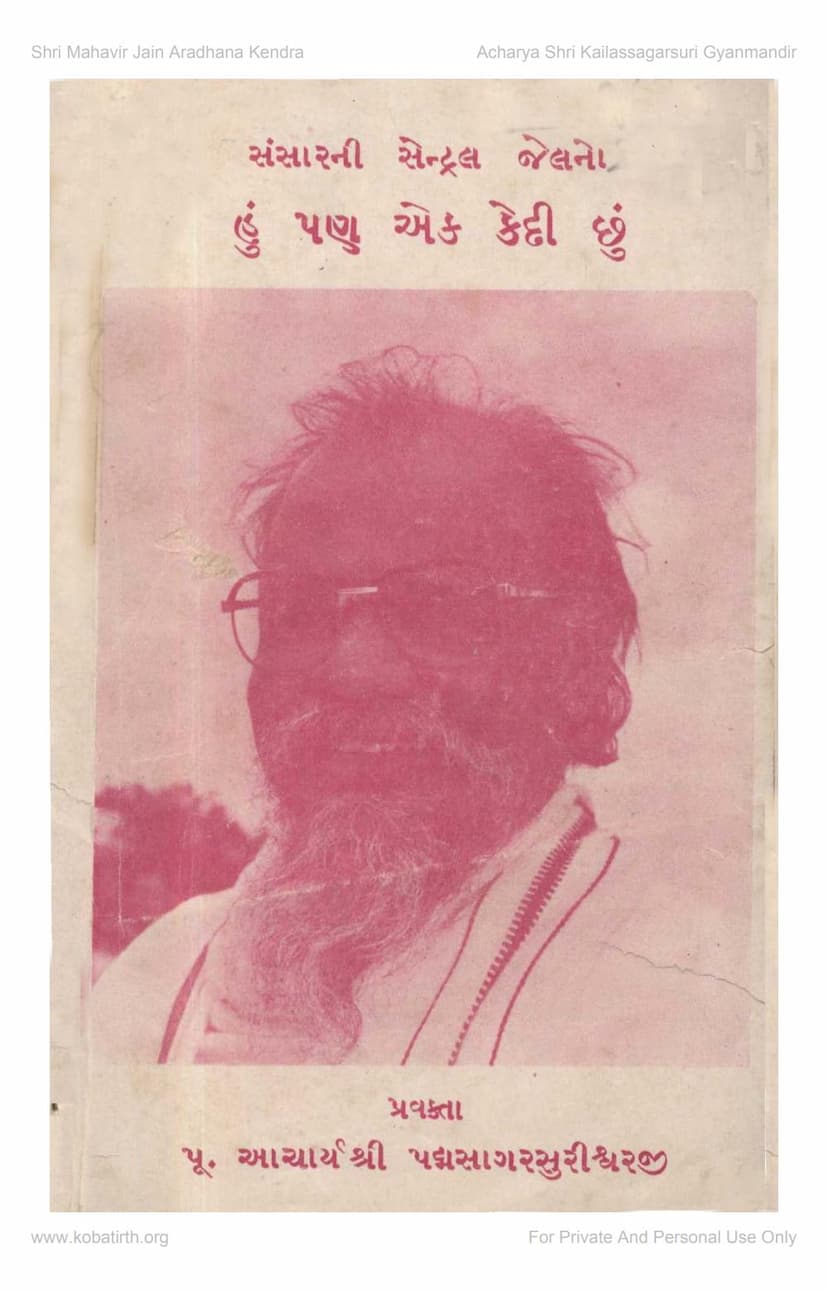Sansarni Central Jail No Hu Pan Ek Kedi Chu
Added to library: September 2, 2025

Summary
This document is a booklet titled "Sansarni Central Jail no Hu pan Ek Kedi Chu" (I too am a prisoner of the world's Central Jail), authored by Poojya Acharya Shri Padmasagarsurishwarji. It was published by Sadvichar Parivar Prakashan.
The core message of the booklet revolves around the concept of life as a form of imprisonment and the path to liberation. Here's a breakdown of the key themes and messages conveyed:
1. The World as a Prison:
- The title itself sets the tone: the author equates the "Central Jail of the world" with the human experience. This implies that all beings are, in a sense, prisoners within the cycle of birth, death, and rebirth, bound by worldly attachments, desires, and actions.
2. The Power of Love and Transformation:
- The booklet emphasizes the transformative power of love, drawing parallels with the story of Saint Tulsidas, who claimed to hold more power than Lord Rama because he had confined Rama within his heart with the lock of love. Love, it's argued, can even subdue the divine and melt hardened hearts.
- The teachings of Lord Mahavir are invoked, highlighting that love brings about lasting change and that the continuous contemplation of righteous thoughts can lead to the transformation of one's heart.
3. Human Fallibility and the Path to Improvement:
- The text acknowledges that humans are born with the tendency to err. However, the true humanity lies in correcting mistakes and elevating one's life.
- The importance of living for others is stressed, stating that God accepts those who dedicate their lives to the well-being of others. Sacrificing one's life for the protection of others is considered a great act of merit.
4. The Danger of the Tongue:
- A significant portion of the booklet focuses on the power and danger of the tongue. It highlights that while we have two eyes and two ears for a single purpose, the tongue, though singular, has two functions: eating and speaking.
- The text warns that speaking falsely can lead to conflict and the destruction of one's entire life. It contrasts the unguarded eyes, ears, and nose with the tongue, which is protected by 32 teeth.
- The distinction between a wise person and a fool is made: a fool regrets after speaking, while a wise person thinks before speaking. A wise person's speech is controlled by discretion and aims to spread fragrance, provide solace, and spread love.
5. The True Nature of Religion and Devotion:
- The booklet clarifies that true religion doesn't begin with temples or mosques but with the tongue and ends with our mistakes.
- It suggests that the packaging of religion (Hindu, Muslim, Jain, Christian) doesn't matter; the essence is the divine and humanity itself. The example of a cow producing white milk regardless of its color is used to illustrate this point.
- The ideal of "Ram Rajya" envisioned by Mahatma Gandhi is explained as each person living according to the true principles of their respective religion, leading to a virtuous society.
- Genuine prayer requires a heartfelt connection, a thirst to attain God, and remorse for one's sins. Without the purification of the mind and heart, spiritual attainment is impossible.
6. Contemplation of Death and Avoiding Sin:
- The text repeatedly emphasizes the inevitability of death. Reflecting on one's death can prevent one from committing sins or at least delay them.
- The booklet encourages introspection, reminding readers that each step taken brings them closer to death. It warns about the dire consequences of committing sins, especially when one is close to death.
- Material possessions, physical strength, and power are transient. The booklet quotes the poet Ghalib, urging the reader to remember the impermanence of the body.
7. Liberation from the "Prison":
- The ultimate goal is to break free from the "prison" of worldly attachments. This liberation comes through a change in thoughts and actions.
- The booklet encourages living a life of virtue, purity, and compassion. It urges readers to become their own gatekeepers against negative thoughts and actions.
- Causing suffering to others will inevitably lead to one's own unhappiness. The ideal is to live a life that spreads fragrance and light.
8. The Author's Identification with the Prisoners:
- In a poignant conclusion, the author acknowledges that he too is a prisoner, just like those in the "Central Jail of the world." He likens the imprisonment of the convicts to their own imprisonment within the cycle of existence due to their actions against God.
- He emphasizes that true freedom lies in overcoming these self-imposed or karmically bound limitations.
In essence, "Sansarni Central Jail no Hu pan Ek Kedi Chu" is a spiritual discourse that uses the metaphor of a jail to describe the human condition. It advocates for a life guided by love, ethical conduct, self-awareness, and a constant contemplation of mortality to achieve spiritual liberation and a meaningful existence.
The latter pages (23-24) highlight the philanthropic activities of the "Sadvichar Parivar," including their work with disabled individuals and eye care initiatives, suggesting a practical application of their spiritual teachings.